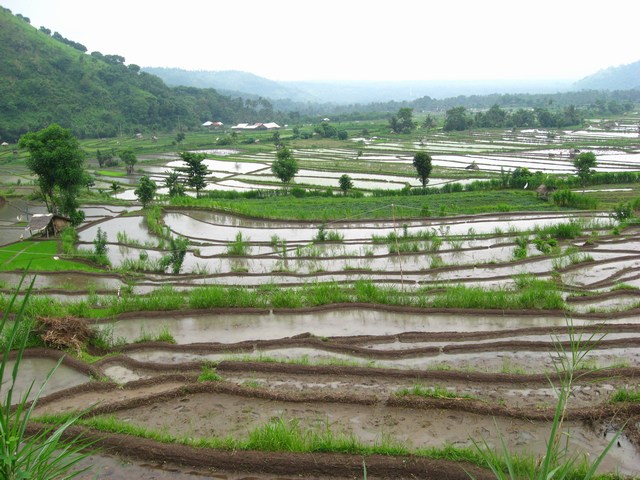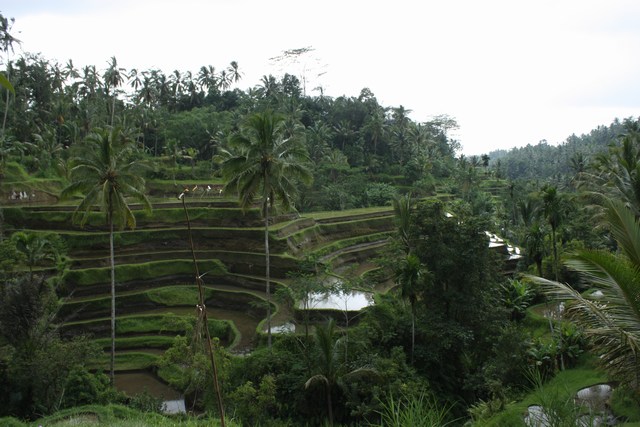 Rice terraces are synonymous with Bali and the dominant part of the scenery. Rice farming in Bali dates back to Neolithic times. Bali’s steep mountains and deep gorges make wet rice farming difficult, so the Balinese have developed an intricate system of terraced rice fields, governed by a subak (water sharing community).
Rice terraces are synonymous with Bali and the dominant part of the scenery. Rice farming in Bali dates back to Neolithic times. Bali’s steep mountains and deep gorges make wet rice farming difficult, so the Balinese have developed an intricate system of terraced rice fields, governed by a subak (water sharing community).
Balinese also believe that Dewi Sri, the Goddess of rice, must be honoured and shrines are set up in every sawah to honour her. The Balinese believe that Dewi Sri dwells in every stalk of rice and during harvesting Balinese women use a small curved knife hidden in their palm, cutting only a few stalks with every cut so not to scare Dewi Sri. Rice means life to the Balinese and is much more than something to fill a belly. Rice has 3 names: When still in the sawah its called padi, in the sack it is beras, on the plate its nasi.
Visitors to Bali have an abundance of places and attractions to visit besides the chaos of shopping and partying in the tourist strip. Bali is renowned for its numerous temples and other places of worship. However, wherever visitors go into the countryside on day trips it is inevitable they will see the rice terraces that adorn the faces of hills and mountains, the higher you go in elevation on the island, the more spectacular the rice terraces. These terraces are a classic feature on the landscape of Bali and are the rice cultivation on varying levels that follow the natural contours of the escarpments. These rice terraces off some of the most spectacular panoramas and most are, breathtaking.
I have always found the best times to photograph these magnificent views is either early in the morning or late in the afternoon. During these times the sun is less harsh and enables the richness of the colours to be more defined.
Tegallalang: The 7klm stretch of road leading northwards from Ubud to Pujung passes through Tegallalang; without a doubt the finest view in Bali. The rice padi views are in the valley located in a kilometre stretch along the road are a tourist drawcard. You will certainly know when you have arrived at this spot by the numerous cars and tourist buses crammed onto the side of the road.
One thing you must remember in this place is crossing the road to obtain a good vantage point to take your fotos. Many times over the years I have seen tourists crossing aimlessly and nearly becoming a bonnet ornament. There are several vantage points located down a few steps to shops and warungs.
Naturally, the owners will attempt to sell you their wares but, even worse are the hawkers on the road who literally shove artefacts into your face. Just ignore them. It can get fairly busy here and at times competitive for the best places to take fotos of the view. Just enjoy!

Jataluwih: Located in the region of Tabanan, Jataluwih is the most striking examples of terraced agriculture in the world. The road north from Tabanan to Jataluwih takes you through some of the most famous rice-paddy views on the island. There are expansive panoramas over the gently sloping terraces and it truly is surreal. It is, without a doubt, Bali’s oldest and most complex example of the Subak rice terrace system of agriculture.
Located in vary convenient places along the road are some great, small restorans to sit and view the splendour. After you have completes all your photography of this stunning place then I would recommend sitting in the Jataluwih Café and enjoying a cold one whilst watching the sunset.
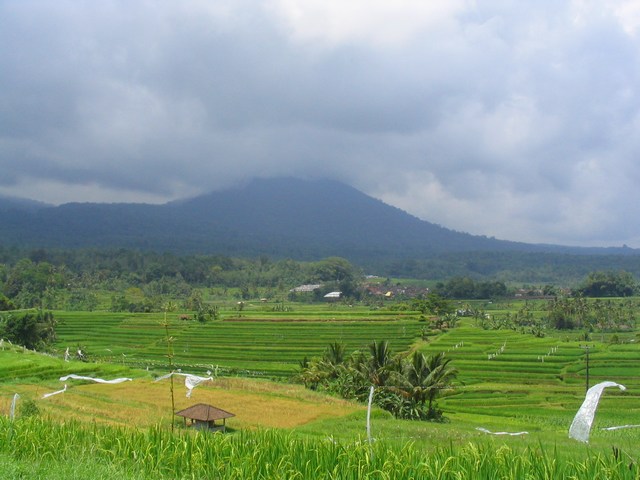
Belimbing: On the road north to Pupuan is a small place called Belimbing and although you really can’t see the village from the road you will see an isolated warung that is a great place for a rest stop.
When you walk through the back of the shop to the rear of the premises there are some shaded wooden tables and chairs. It’s not the delightful setting or the lovely gardens that are appealing but rather the fabulous views of terraced ricefields at the rear of the place.
What I found most intriguing about this place are the massive fruit bats that hang from a small tree in the courtyard. I walked right past them without even noticing. The other nice thing about this place is that they sell a fabulous collection of packaged spices and nuts.
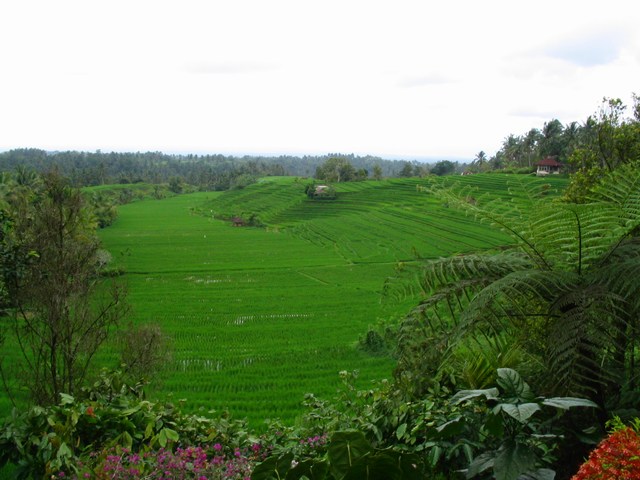
Kekeran: On the road north of Pupuan I came across a great view. As you enter the Kapbupaten of Buleleng along the main Antosari to Mayong road there is a small village, Kekeran. Just off the side of the road you will notice a small one table warung hastily put together with a few old planks and sheets of iron roofing. It is owned by a cheery fellow, Nyoman. His wife is quick to sell you freshly cut Papaya, Mango, and Watermelon and the most delicious Krupuk Pisang, or sliced and fried banana.
But it is the view from the mountain road that is the attraction. Below in the valley expanse, a river winds its way through there, the terraced padi fields symetrically line the faces of the mountains and fields, emerald green and the sheaths of padi sway in the light breeze.
From the warung you can see as far as ten kilometres and even the road you were just on to get to this point. Nyoman was telling me he has had this spot for five years and delights in meeting all the visitors who come to his plot of soil. It is a great place to stop for a rest, satiate your thirst and imbibe in some fresh fruit whilst being spoilt by the beauty before your eyes.
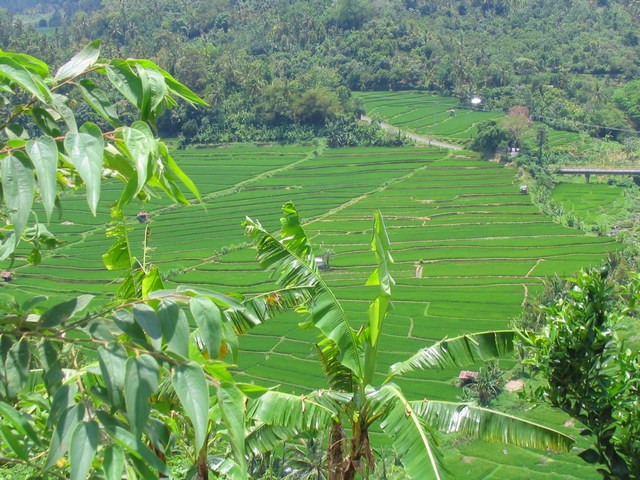
Rendang: an area where you will find few travellers; an area where the locals look at you with suspicion and wonder. The scenery is nothing short of spectacular; narrow roads weaved through the lush, green jungle, the road seemingly disappearing as you descend and then suddenly rise to another panorama of jungle growth inter-dispersed with ramshackle houses and patches of rice paddies.
It was my outright curiosity and with the aid of a strategically placed sign half-buried in the jungle that caused me to turn down the narrow path and descend into a wide open area where I found the Lereng Agung Restoran. The view is stunning.
Deep in the valley below was a patchwork of paddy fields stretching as far as the eye could see; a collar of high trees the edge and above all this rising out of it all the mighty Gunung Agung; Bali’s highest mountain and on its slopes the sacred mother temple of Pura Besakih.
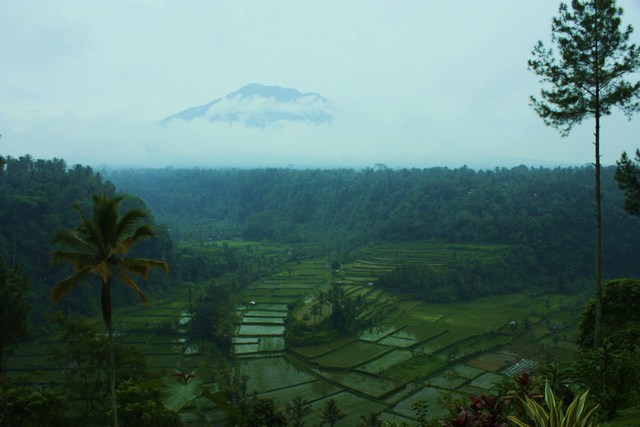
Abang & Ngis: One place on the east coast of the island that is seldom seem by regular tourists that, in my opinion, is the most stunning and beautiful panoramic view of rice fields on the whole island is a place called Ngis, a small village barely visible from the main road.
If you travel to Amlapura on the east coast then head north from there to the village of Abang, just in between these two places you will come to a sharp bend in the road and here you will find the heavenly view. There are small gravel places to park off the side of the road. The best time to really appreciate this stunning panorama is late afternoon and an ideal time for taking photos here.
